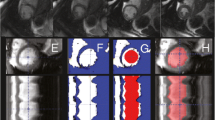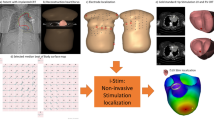Abstract
Improper electrocardiogram (ECG) lead placement resulting in suboptimal gating may lead to reduced image quality in cardiac magnetic resonance imaging (CMR). A patientspecific systematic technique for rapid optimization of lead placement may improve CMR image quality. A rapid 3 dimensional image of the thorax was used to guide the realignment of ECG leads relative to the cardiac axis of the patient in forty consecutive adult patients. Using our novel approach and consensus reading of pre- and post-correction ECG traces, seventy-three percent of patients had a qualitative improvement in their ECG tracings, and no patient had a decrease in quality of their ECG tracing following the correction technique. Statistically significant improvement was observed independent of gender, body mass index, and cardiac rhythm. This technique provides an efficient option to improve the quality of the ECG tracing in patients who have a poor quality ECG with standard techniques.




Similar content being viewed by others
References
Lanzer P, Botvinick EH, Schiller NB, Crooks LE, Arakawa M, Kaufman L, Davis PL, Herfkens R, Lipton MJ, Higgins CB (1984) Cardiac imaging using gated magnetic resonance. Radiology 150(1):121–127
Rokey R, Wendt R, Johnston D (1988) Monitoring of acutely ill patients during nuclear magnetic resonance imaging: use of a time varying filter electrocardiographic gating device to reduce gradient artifacts. Magn Reson Med 6:240–245
Shetty A (1988) Suppression of radiofrequency interference in cardiac gated MRI: a simple design. Magn Reson Med 1:84–88
Damji A, Snyder R, Ellinger D, Witkowski F, Allen P (1988) RF Interference suppression in cardiac synchronization system operating in a high magnetic field NMR imaging system. Magn Reson Imaging 6:637–640
Fischer S, Wickline S, Lorenz C (1999) Novel real-time R-wave detection algorithm based on the vectorcardiogram for accurate gated magnetic resonance applications. Magn Reson Med 47:361–370
Crowe ME, Larson AC, Zhang Q, Carr J, White RD, Li D, Simonetti OP (2004) Automated rectilinear self gated cardiac cine imaging. Magn Reson Med 52(4):782–788
Larson AC, White RD, Laub G, McVeigh ER, Li D, Simonetti OP (2004) Self-gated cardiac cine MRI. Magn Reson Med 51(1):93–102
Conflict of Interest
No author/contributor of this study has competing interests to disclose.
Author information
Authors and Affiliations
Corresponding author
Rights and permissions
About this article
Cite this article
Barnwell, J.D., Klein, J.L., Stallings, C. et al. Image-guided optimization of the ECG trace in cardiac MRI. Int J Cardiovasc Imaging 28, 587–593 (2012). https://doi.org/10.1007/s10554-011-9865-7
Received:
Accepted:
Published:
Issue Date:
DOI: https://doi.org/10.1007/s10554-011-9865-7




